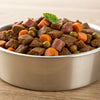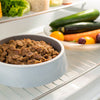How Often Should You Feed Wet Dog Food? A Comprehensive Guide
- Houndsy
Table of Contents
- Introduction
- Understanding Wet Dog Food
- How Often Should Dogs Have Wet Food?
- Tips for Transitioning to Wet Food
- Creating a Balanced Diet
- The Role of Houndsy in Elevating Pet Care
- Conclusion
Introduction
Did you know that around 59% of dogs in the United States are considered overweight? As responsible pet owners, ensuring that our furry friends are receiving the proper nutrition is crucial for their health and well-being. One pressing question among dog parents is: how often should we feed wet dog food? This topic is not merely about frequency; it embodies various aspects, including ensuring our pups stay hydrated, addressing their dietary needs, and creating a consistent feeding routine that complements their lifestyle.
In this blog post, we will delve into the essentials of incorporating wet dog food into your pet's diet. We will examine the benefits of wet food, recommended feeding frequencies based on different factors such as age and size, and best practices for a seamless transition if you’re integrating wet food into your dog’s diet. By the end of this article, you will be equipped with comprehensive knowledge that will help optimize your dog’s nutritional intake and enhance their overall dining experience.
Let’s embark on this journey to elevate our pets' feeding rituals together!
Understanding Wet Dog Food
What is Wet Dog Food?
Wet dog food, often found in cans or pouches, is characterized by its substantial moisture content, typically ranging from 70% to 80%. This high moisture content can be particularly beneficial for dogs that may struggle to drink enough water. Wet dog food usually consists of meat, grains, and vegetables, providing a rich nutritional profile.
Benefits of Wet Dog Food
1. Hydration
Wet food can assist in keeping your dog hydrated, especially for those who tend to drink less water. Hydration is vital for digestion, regulating body temperature, and maintaining overall health.
2. Palatability
The flavors and aromas from wet dog food often make it more enticing to dogs, especially those who may be picky eaters or older dogs with diminished appetites.
3. Digestibility
The softer texture of wet food can be easier for dogs with dental issues or those recovering from surgery to consume. It can help them maintain their quality of life even as they age or face health challenges.
4. Nutritional Variety
Many brands offer diverse flavors and formulations, catering to specific nutritional requirements. By mixing different types of wet food, we can provide our dogs with a broader spectrum of nutrients.
Nutritional Considerations
When choosing wet dog food, always examine the label for a "complete and balanced" statement confirming it meets the nutritional standards enforced by the Association of American Feed Control Officials (AAFCO). This ensures that the food contains all the essential nutrients your dog needs for their specific life stage.
How Often Should Dogs Have Wet Food?
Age and Size Considerations
The frequency and amount of wet food we serve our dogs can vary significantly based on their age, size, and overall health. Let’s break down these factors:
1. Puppies:
Young dogs have fast metabolisms and often require more frequent meals. Typically, puppies under six months old should be fed three to four times a day. If incorporating wet food, monitor the amounts to ensure they receive the necessary calories. It’s crucial to understand their growing needs.
2. Adult Dogs:
For adult dogs, feeding them once or twice a day is usually sufficient. Many pet owners alternate between giving wet food at one meal and dry kibble at another to maintain variety while meeting both hydration and nutritional needs.
3. Senior Dogs:
As dogs age, they may experience changes in appetite or certain health conditions that require adjustments in their feeding routine. Elderly dogs may benefit from wet food more frequently (up to twice a day), as its texture can be easier for them to chew. If a senior dog displays a reduced interest in meals, wet food can serve as an enticing nutrition source.
Feeding Strategies
When determining how often to feed wet dog food, consider these effective strategies:
1. Scheduled Feeding:
Establish set meal times to regulate your dog’s eating behaviors and prevent overeating (which can lead to obesity).
2. Free-Choice Feeding:
While some pet owners allow their dogs to graze throughout the day by keeping food bowls full, this method can often lead to weight issues, particularly with wet dog food, due to spoilage.
Mixing Wet and Dry Food
Mixing wet and dry food can be beneficial for many dogs. This approach not only diversifies the diet but also increases palatability. If you decide to combine the two, adjust portion sizes accordingly. For instance, if you typically give your dog one cup of dry food, consider reducing that amount and offering half a can of wet food instead.
Tips for Transitioning to Wet Food
If you’re contemplating adding wet food to your dog’s diet, the following strategies can facilitate a smooth transition:
1. Gradual Introduction:
Start by mixing a small amount of wet food with your dog's dry food. Gradually increase the wet food proportion over several days or weeks to prevent digestive upset.
2. Monitor Reactions:
Pay attention to how your dog's body reacts to wet food during the transition period. If you notice any signs of discomfort or allergies, consult your veterinarian.
3. Portion Control:
Make sure to adjust the total amount of food provided to account for the calories in wet food to prevent overfeeding and maintain a healthy weight.
4. Storage and Freshness:
After opening a can or pouch of wet food, store it in the refrigerator and use it within a few days. It’s a good idea to serve the food at room temperature to enhance its aroma and flavor.
Creating a Balanced Diet
Portion Control
Proper portion sizes are essential when feeding wet food. Many brands include feeding guidelines based on your dog’s weight. For example, a 30-pound dog may require approximately 2 to 3 cans of wet food a day, depending on caloric density. Always refer to the packaging for specific instructions.
Consultation with a Veterinarian
If you are ever uncertain about how much wet food to incorporate into your dog’s daily diet, consulting with a veterinarian is wise. They can offer personalized recommendations tailored to your dog’s health needs and lifestyle.
The Role of Houndsy in Elevating Pet Care
At Houndsy, we understand that feeding your pet should be a simple and enjoyable experience. Our flagship product, the Houndsy Kibble Dispenser, is designed for pet owners who value both functionality and aesthetics. The dispenser allows for precise portion control while seamlessly integrating with your home decor, elevating the feeding ritual.
Using our Houndsy Kibble Dispenser guarantees that your dog receives the ideal amount of food consistently while also enhancing the visual appeal of your home. Discover more about how our product can simplify your dog feeding experience here.
Conclusion
Understanding how often and how much to feed your dog wet food is vital for maintaining their health and well-being. By considering factors like their age, size, and individual needs, we can create a feeding routine that works best for our beloved companions. Incorporating wet food into their diet can bring numerous benefits, such as improving palatability, hydration, and overall nutrition.
Moreover, as pet parents, we have the opportunity to enhance our dogs' feeding experiences through thoughtful products and practices, such as the Houndsy Kibble Dispenser. This innovative solution not only ensures perfect portions but also adds a touch of elegance to our home.
Are you ready to revolutionize your dog's feeding experience? Explore our Kibble Dispenser today!
FAQ
-
Can I mix wet and dry dog food?
Yes! Mixing wet and dry food can provide a balanced diet and enhance the palatability of meals. Just remember to adjust the portion sizes accordingly. -
How often should I feed my puppy wet food?
Puppies generally require more frequent meals, typically three to four times a day. Monitor their growth and adjust portions as needed. -
Is wet food better for older dogs?
Wet food can be particularly beneficial for senior dogs given its softer texture and higher moisture content, which encourages them to eat, especially if they have dental issues. -
How do I store opened wet dog food?
Once opened, wet dog food should be stored in the refrigerator and used within a few days to maintain freshness. -
What should I do if my dog refuses to eat wet food?
If your dog is hesitant to eat wet food, try mixing it with their regular dry food or warming it slightly to enhance the aroma. If they continue to refuse, consult your veterinarian for advice.













